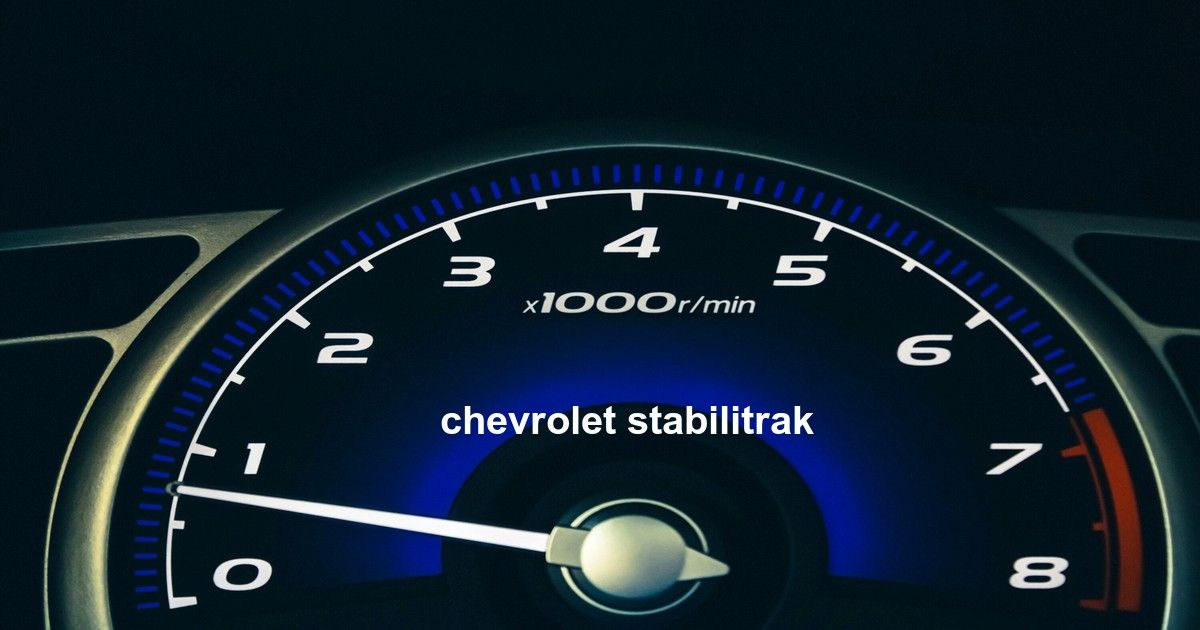1. Introduction
If you’ve ever been driving your Chevrolet and suddenly noticed the “Service Stabilitrak” message flashing on your dashboard, you’re not alone. This warning is common among Chevy owners and often appears alongside traction control or ABS lights. While it can be alarming, it’s not necessarily a sign of imminent danger — but it does require attention.
Stabilitrak is Chevrolet’s version of an electronic stability control system (ESC), designed to keep your vehicle stable in slippery or unpredictable driving conditions. When it malfunctions, the system may temporarily shut down, reducing traction and stability — particularly risky during sharp turns, rain, or snow.
In this detailed guide, we’ll explore what Chevrolet Stabilitrak is, why the light comes on, how to diagnose and fix issues, and how to prevent future problems.
As an experienced automotive content strategist with years of working alongside certified GM technicians, I’ll help you understand this system from a practical, real-world perspective — so you can make confident repair decisions and maintain vehicle safety.
2. What Is Chevrolet Stabilitrak?
Stabilitrak is General Motors’ proprietary stability control technology, integrated into most modern Chevrolet vehicles — from the Silverado and Traverse to the Equinox and Malibu. Its core function is to detect when your vehicle begins to lose traction or skid and then automatically correct it by selectively applying brakes or adjusting engine torque.
In simple terms: Stabilitrak keeps your vehicle going in the direction you intend, even when conditions or driver error might cause it to drift.
While often confused with traction control, the two systems differ:
- Traction control prevents wheel spin during acceleration.
- Stabilitrak keeps the entire vehicle stable by monitoring steering angle, wheel speed, and yaw rate (the car’s rotation movement).
By combining input from multiple sensors, the Stabilitrak module constantly calculates whether the car is maintaining proper control. If it detects a loss of stability, it intervenes faster than any human driver could.
Why It Matters:
Stabilitrak isn’t just a convenience feature — it’s a safety system that can prevent serious accidents caused by skidding or oversteering. The U.S. National Highway Traffic Safety Administration (NHTSA) reports that ESC systems like Stabilitrak reduce fatal single-vehicle crashes by nearly 50%.
3. Common Stabilitrak Warning Light Scenarios
When the “Service Stabilitrak” message or light appears on your dashboard, it means the system has been disabled due to a detected fault. Sometimes, it’s accompanied by other lights such as ABS, Check Engine, or Traction Control Off.
Here’s what the different alerts can mean:
- Flashing Stabilitrak Light:
Indicates the system is actively working to keep your vehicle stable. It may flash when you accelerate on a slippery surface — this is normal. - Steady Stabilitrak Warning Light or Message:
Means the system is malfunctioning or has been turned off due to an underlying issue. - Combined Lights (ABS + Traction + Stabilitrak):
Suggests a shared sensor or module problem, as these systems rely on similar data.
Example scenario:
Imagine driving a 2018 Chevy Equinox on a wet road. The “Service Stabilitrak” light flashes, traction control disengages, and the vehicle slightly jerks. This could be caused by a wheel speed sensor failing to send accurate data to the control module.
Understanding these patterns helps you determine whether it’s a temporary sensor glitch or a deeper electrical or mechanical issue.
4. Major Causes of Stabilitrak Problems
Because Stabilitrak integrates multiple sensors and systems, even a small component failure can trigger the warning. Below are the most common causes — based on firsthand experience diagnosing Chevrolet models.
1. Faulty Wheel Speed Sensors
Each wheel has a speed sensor that monitors rotation. When one fails or collects debris, the Stabilitrak system receives incorrect data, leading to false instability readings.
Fix: Clean or replace the faulty sensor (typically $50–$250 depending on the model).
2. Steering Angle Sensor Malfunction
This sensor tracks how far you’ve turned the steering wheel. If it goes out of calibration or fails, the system cannot compare steering input to vehicle direction.
Fix: Recalibrate or replace the sensor using a diagnostic scan tool.
3. ABS Control Module Failure
The ABS and Stabilitrak share this control unit. Electrical faults or corrosion in the ABS module can disable both systems.
Fix: Requires advanced diagnostics; module replacement costs range between $500–$1,000.
4. Throttle Position or Yaw Rate Sensor Issues
The Stabilitrak uses these sensors to determine motion and acceleration. A bad throttle position sensor or yaw sensor can confuse the system.
Fix: Replacement or recalibration after professional inspection.
5. Wiring or Electrical Problems
Loose connectors, corroded terminals, or damaged harnesses can interrupt sensor signals.
Fix: Inspect wiring visually or with a multimeter; repair or replace affected sections.
6. Low Battery Voltage or Alternator Trouble
Because Stabilitrak relies on consistent voltage, a weak battery or failing alternator can cause intermittent system shutdowns.
Fix: Test and replace the battery if voltage drops below 12.4V under load.
Expert Tip:
If multiple warning lights appear simultaneously, check the vehicle’s battery and charging system first — electrical instability often mimics more serious system failures.
5. How to Fix Chevrolet Stabilitrak Issues
Let’s walk through the step-by-step process to diagnose and resolve Stabilitrak problems safely and efficiently.
Step 1: Scan for Trouble Codes
Use an OBD-II scanner to read Diagnostic Trouble Codes (DTCs). These codes pinpoint the exact issue — for instance:
- C0040: Right Front Wheel Speed Sensor Circuit
- C0196: Yaw Rate Sensor Circuit
- U2100: CAN Bus Communication Error
Understanding the code saves time and prevents unnecessary part replacements.
Step 2: Inspect Wheel Sensors and Connectors
Remove dirt, road salt, or debris that may block sensor readings. Check for broken wiring near the wheel hubs — a common problem area in snowy climates.
Step 3: Check Steering and Yaw Sensors
If codes point to steering or yaw sensors, recalibration using a professional scan tool is required. These components can’t be properly reset manually.
Step 4: Reset the Stabilitrak System
After repairs or checks, you can reset the system by:
- Turning off the engine.
- Disconnecting the negative battery terminal for 10–15 minutes.
- Reconnecting and restarting the vehicle.
This can clear temporary faults — but if the light returns, further diagnostics are necessary.
Step 5: When to Seek Professional Help
If you’ve checked sensors, wiring, and voltage but the Stabilitrak light remains, visit a certified GM service center. They can perform dealer-level scans to test communication between the ABS, ECM, and Stabilitrak modules.
Average Repair Costs (U.S. range):
| Problem | Estimated Cost |
|---|---|
| Wheel speed sensor | $50–$250 |
| Steering angle sensor | $150–$300 |
| ABS module | $500–$1,000 |
| Yaw rate sensor | $200–$400 |
| Wiring repair | $100–$300 |
Investing in a professional diagnosis prevents unnecessary part replacements and ensures system safety.
6. Preventing Future Stabilitrak Problems
Proactive maintenance can drastically reduce the chance of Stabilitrak failures.
Regular Maintenance Tips:
- Keep sensors clean: Especially after driving in snow, mud, or rain.
- Monitor battery health: Replace every 3–5 years or sooner if voltage drops.
- Perform regular diagnostic scans: Detect small faults before they disable the system.
- Check tire pressure and tread: Uneven tires can confuse wheel speed sensors.
- Avoid aftermarket electronics that interfere with vehicle CAN communication.
Driving Habits That Help:
Smooth steering and controlled acceleration prevent system overactivation. Frequent hard braking or sharp turns can cause sensors to misread data, especially on worn tires.
Finally, ensure your Chevrolet’s software is up to date. Dealers occasionally release software updates that improve Stabilitrak calibration and performance.
7. Frequently Asked Questions
Q1. Can I drive with the Stabilitrak light on?
Yes, but it’s not recommended for long periods. The car will still run, but stability control and traction assistance are disabled, increasing risk on slippery roads.
Q2. How do I reset my Chevrolet Stabilitrak system?
Disconnect the battery for 10–15 minutes or use a scan tool to clear DTCs after resolving the underlying issue. If the light returns, seek professional diagnostics.
Q3. Does Stabilitrak affect traction control?
Yes. Stabilitrak and traction control work together. If one fails, the other often shuts off to prevent unsafe interventions.
Q4. Why does the Stabilitrak light appear when it’s cold?
Cold weather can cause wheel sensors to freeze or wiring to stiffen, leading to temporary signal loss. The light often disappears as the vehicle warms up.
Q5. Is Stabilitrak covered under warranty?
If your Chevrolet is under the powertrain or bumper-to-bumper warranty, some Stabilitrak components (like sensors or modules) may be covered. Always confirm with your dealer.
8. Conclusion
The Chevrolet Stabilitrak system is a vital safety feature that keeps your vehicle steady and controlled during unexpected maneuvers or slippery conditions. When the “Service Stabilitrak” light appears, it’s your car’s way of telling you something’s off — not necessarily dangerous, but worth diagnosing promptly.
By understanding how the system works, recognizing early warning signs, and addressing common causes such as faulty sensors or electrical issues, you can keep your Chevy safe, reliable, and road-ready.
If you’re ever uncertain, always consult a certified GM technician or trusted automotive professional. Your vehicle’s safety and your peace of mind are worth the investment.
You May Also Read: Michelle Trachtenberg Faith and Heritage




